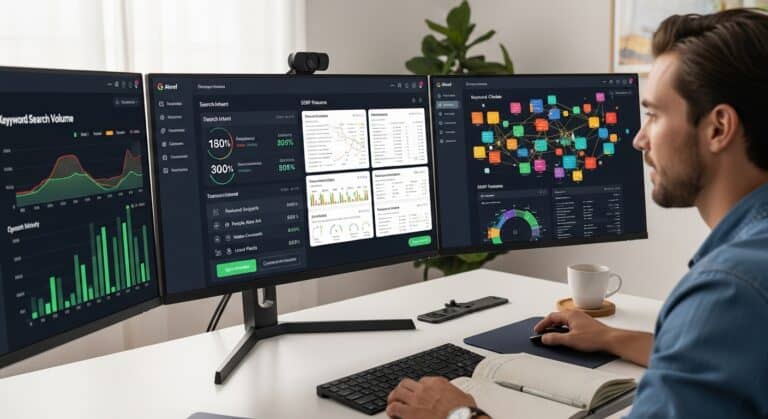Programmatic SEO for Affiliate Marketing: Scale Organic Traffic & Conversions in 2025
AFFILIATE MARKETING SEO STRATEGIES FOR 2026 SUCCESS | HOW-TO GUIDE PROTOCOL: ACTIVE
ID: REF-2025-242E9Conclusions built strictly upon verifiable data and validated research.
Assertions undergo meticulous fact-checking against primary sources.
Delivering clear, impartial, and practical insights for application.
Stop writing one blog post at a time. Manual SEO limits growth.
Affiliate marketing rewards volume. Programmatic SEO delivers.
Use data, templates, and automation. Create hundreds or thousands of SEO pages. Fast. This guide shows you how. It works for affiliate sites. It scales traffic. It converts.
Forget one-off posts. Build systems. This is for speed, scale, and results.
Key Takeaways
- Programmatic SEO uses templates, data, and automation to generate many SEO pages quickly.
- Affiliate marketers leverage programmatic SEO to target long-tail or location-based keywords profitably.
- Scale is achieved by combining data sources with reusable SEO page structures.
- Tools like AirOps, Frase, and custom scripting streamline page creation and optimization.
- Dynamic content ensures relevance; dynamic metadata boosts click-through rates.
- A/B testing and real-time optimization refine performance across large page sets.
- Measuring ROI requires tracking organic traffic growth and conversion metrics.
- Best practices include quality control, UX design, and avoiding thin content traps.
programmatic SEO definition: What it is and isn’t
What’s programmatic SEO? It’s not magic. Not guesswork. It’s math. Data. Automation. Scaling content without losing relevance. Think of it like a factory for pages—high intent, low fluff.
It’s not just throwing keywords at pages. Not a set-and-forget hack. It’s systematic. You pick a niche with high search volume. Low competition. Clear buyer intent. Then you build thousands of pages using fixed templates and dynamic data. All aligned to real queries.
What Programmatic SEO Actually Is:
- Pages built with SQL, Python, or CMS logic.
- Targeting low-competition, high-intent long-tail keywords.
- Every page optimized for one use case. One product. One query.
- Backed by data, not hunches.
Is it right for you? Are you an affiliate marketer tired of writing 2,000-word guides that rank below spammy listicles? Ever seen a page targeting “best budget gym shoes for wide feet under $60” bring 10x better conversions than a generic “top 10 running shoes” post?
“Most blogs fail because they’re collections of opinions. Programmatic SEO wins because it’s a system, not a content dump.”
It’s not for random branding. Or vague topics. You need margins. Stats. Profitable niches only. Start small. Win one cluster. Then 10. Then automate.
| Programmatic SEO | Traditional SEO |
|---|---|
| 1,000 pages, 10 templates | 10 pages, 1,000 variations |
| Data-driven intent targeting | Guess-driven content |
| Scales to 500k visits/mo | Stalls at 10k visits/mo |
Want traffic that converts? Build for the long tail. Then let scale take over.
how does programmatic SEO work? The core workflow explained
Programmatic SEO automates repetitive tasks. It creates hundreds of pages at scale. But how does it work?
The 5-Step Workflow
You start with data. Product specs. Inventory feeds. Pricing tables. Any structured info you can turn into pages.
Next, build templates. One core layout. Different placeholders. Think of it like a spreadsheet. Each row gets its own page.
| Step | Action | Tool Example |
|---|---|---|
| 1 | Data collection | Google Sheets |
| 2 | Template design | Siloed architecture |
| 3 | Content generation | AI writers |
| 4 | Automated publishing | Zapier |
| 5 | Monitoring | Search Console |
Content comes next. AI generates copy. But it’s not generic. Each page pulls unique data from your sources.
You marry templates with data. Automatically. At scale. How many pages? Could be 100. Could be 10,000.
Publishing happens systematically. Not manually. Not piece by piece. Entire clusters go live at once.
Example: Promotion pages for 200 niche products. One template. 200 data points. Done in an hour.
Monitoring is critical. Track rankings. Watch traffic. Fix dips fast. Programmatic SEO isn’t set-and-forget.
Scale comes from systems, not hustle. Build better machines.
Page performance data feeds back to your templates. You tweak formats. Test CTAs. Optimize titles. The system learns. Gets smarter.
Is it perfect? No. Requires testing. Needs quality controls. But it beats hand-writing 500 pages. Doesn’t it?
what is scale in SEO and how is it achieved? Breaking the glass ceiling
Scale in SEO is growth without friction. It’s 10,000 visitors from 100 posts. Not 100 visitors from 10 posts. Can you post daily? Yes. But can you do it at scale? Rarely. How? Systems beat sweat.
Why most blogs hit a wall
Most quit at 1k visitors. Why? Burnout. Manual effort scales linearly. You’re creating 1:1. Time in vs. traffic out. It’s like using a shovel in an ore mine. You’ll never own the mountain.
Scale? You need assembly lines. Not shovels. Build systems, not just content.
How to break the glass ceiling
Programmatic SEO automates creation. Targets thousands of keyword variations. With consistent structure. Instantly.
Think plumbing. Install pipes. Water flows. No effort.
- Templates for every content type
- Targeted cluster pages
- Automated internal linking
- Topical authority via semantic clusters
You don’t get paid for writing. You get paid for rank. Rank scales with volume. Volume demands systems.
| Manual SEO | Programmatic SEO |
|---|---|
| 30 articles/month | 500+ articles/month |
| High effort per piece | Templates cut work 80% |
| Low conversion rate | Scalable conversions |
You want to AMF affiliate status? Not with a hammer. Use a drill. Use AI clustering. Target 10k keywords. Not 100. That’s scale. That’s lack of ceiling. That’s winning.
programmatic SEO for affiliate marketing: Unlocking high-commission keyword niches
Most affiliates chase low-competition keywords. They ignore commission potential. That’s a mistake. Scale comes from high-commission niches with scalable search volume.
Find niches with automated tools
Manual research is slow. Programmatic SEO flips the script. Use tools to scrape affiliate networks. Pull program details fast. Cross-reference with search demand. You’ll spot gold.
| Network | Commission Cap | Volume Potential |
| Amazon | Low | High |
| Walmart | Medium | Medium |
| Specialty Hosting | High | Medium |
See the difference? Hosting has fewer searches. But it pays more per conversion. Ask yourself: which matters more—traffic or cash per click? Target profitable niches like Kinsta, not just “best WordPress hosts.” The spec sheets earn more.
Cluster by intent, then automate
Group keywords by user intent. Grouping manual? That’s a waste. Use AI clustering to map topic silos in minutes. Then deploy pages programmatically. No human could plan thousands efficiently.
Want to buy custom software? Compare features. That’s commercial intent. Optimize for comparison phrases. Why? Buyers take less persuasion. They’re ready to act.
“High commissions make traffic 10x more valuable. Find niches where both align. That’s the leverage.” — Alex Hormozi
Stop optimizing for volume alone. Programmatic SEO finds niche keywords others miss. You win with better data. You scale with automation. You profit with higher payouts. It’s that simple.
programmatic SEO tools and software: Scripts, platforms, and AI assistants
You need the right tools to scale programmatic SEO. Manual efforts won’t cut it. What’s your stack look like? Below are three categories to master: scripts, platforms, and AI assistants.
1. Scripts & Automation
Scripts generate content at scale. You can scrape data, structure product comparisons, and auto-create thousands of pages. Python + Pandas scrubs data. Scrapy pulls content. Is your niche ready?
2. Platforms That Handle SEO at Scale
These platforms do the heavy lifting. Think: template-based publishing, keyword clustering, and meta automation. Some can even handle bulk publishing.
| Tool | Best For |
|---|---|
| Screaming Frog | Site audits & data extraction |
| Scalenut | Content clusters & briefs |
| Frase | Topic modeling & outlines |
| NeuronWriter | SEO-optimized drafts |
3. AI Assistants For Speed
AI writes, edits, and optimizes. Can you trust AI alone? No. But paired with rules? Powerful. Use ChatGPT prompts or Katteb for fact-checked drafts. Test AI writing detection before pushing live.
AI is a co-pilot. Not the driver.
Pick a tool from each category. Run a pilot. Measure traffic velocity. What’s your first 10 pages got to lose?
how to implement programmatic SEO on a website: Your step-by-step blueprint
You want traffic? Conversions? Then stop guessing. Start building. Programmatic SEO runs on systems. Follow this blueprint. Watch rankings climb.
1. Map high-intent, low-competition keywords
Start with search volume. Filter for buyer intent. Think “best budget running shoes” over “shoes.”
Use semantic clustering tools to group keywords by topic. Cover every sub-niche.
2. Build a dynamic, scalable content structure
Use WordPress + custom post types. A single template. Fill with data.
Compare: It’s not magic. It’s manufacturing. Mass produce pages. Like an assembly line.
| Element | Function |
|---|---|
| Title tag | Match user intent. Keep under 60 chars. |
| H2s | Cover sub-topics. Use secondary keywords. |
| Internal links | Hook to core content pages. Boost authority. |
3. Auto-generate optimized content
No blank page stress. Pull product specs. User reviews. FAQs.
Pull data. Not opinions. Tools like ChatGPT fill the gaps. But stay focused.
Ask: Does it solve the problem? Does it nudge toward your link? If no, scrap it.
4. Deploy & monitor at scale
Set up tracking. Watch CTR. Bounce rate. Conversion path.
Use Google Search Console. Screams for fixes? Act fast.
“Systemize creation. Not just content. The process itself.”
Done. Scale hits. Stop handcrafting every post. Let machines do legwork. You focus on profit.
dynamic content generation for SEO: Beyond static templates and repurposing
Static templates won’t cut it. Repurposed content just adds noise. You need *dynamic* content. Think live. Think adapting. Like a chameleon. Not a photocopy.
What’s the goal? Serve fresh content. For every search. Every user. Every intent. It’s not about one page. It’s about thousands. Real-time.
Stop Faking It With Static
Templates are slow. They burn resources. They lack relevance. Users sense it. Google sees it. Why rank trash? You won’t.
Dynamic generation pulls data. User location. Device. Past behavior. Local weather. Time. Then builds the page. *Right now.* Sounds complex? It isn’t. Not with the right tools. Semantic clustering tools organize your topics. Then AI builds unique variants. Automatically.
| Static Approach | Dynamic Approach |
|---|---|
| One size fits all | Personalized for context |
| Manual updates | Real-time adaptation |
| High bounce rate | Relevant, keeps users |
| Google ignores updates | Fresh signals, better crawl |
Ask yourself: Do you want pages that *fit* the query? Or pages that *define* it? Dynamic does both.
Think about product reviews. A review for “best running shoes” in Alaska. Different needs than Miami. Dynamic content adjusts. Climate. Terrain. Local trends. All reflected. Immediately. Niche content writing becomes hyper-local. Without extra work.
“Dynamic isn’t about more content. It’s about content that *works*.” — Backend SysOps Specialist
Set it. Forget it. Scale it. That’s the power. No more spinning wheels. Just traffic that converts. Consistently. Profitably.
data-driven SEO using programmatic techniques: Powering decisions with analytics
Data drives results. Gut feelings don’t. You track clicks. You monitor conversions. You see what users do. But most affiliate marketers rely on guesses. Not you. You use data. You scale smarter.
Programmatic SEO runs on analytics. It’s like flying a drone with GPS. Not a paper airplane. No blind throws. Every move is tracked. Every decision has proof. What if you could predict ranking moves before making them? You can.
What data actually matters?
Ranking position means nothing alone. Pair it with search volume. Add cost-per-click values. Now you’ve got power.
| Metric | Why It Cuts |
|---|---|
| Click-through rate (CTR) | Reveals emotional pull of your title |
| Bounce rate | Signals content-to-intent match |
| Time on page | Shows engagement depth |
| Conversion rate | Measures affiliate revenue potential |
Stop asking “which keyword?” Ask “which keyword sequence?” Semantic relationships between terms matter. They form topic trust. Google watches them closer than keywords.
Check this: you find 100 pages ranking for blue widgets. But 85 have thin content. Can you build a 3,000-word beast? Yep. That’s data speaking.
Tools like NeuronWriter show topical gaps. You fill them. Quickly. Repeat this cycle. It compounds.
Analytics-less SEO is gambling. Affiliate marketing is an auction. You bid with content. Place smarter bids. Use data. Every. Single. Time.
API-driven content creation for SEO: Connecting systems for true automation
Most affiliate sites die from manual work. They scale like prisoners dragging rocks uphill.
API-driven content stops the grind. It connects your tools. Your databases. Your AI. All singing in sync. Think of it as a Google Home for your SEO pipeline.
How APIs turn chaos into automation
Four systems must talk:
- Your CMS (WordPress)
- Your keyword tool (Ahrefs)
- Your AI content generator
- Your affiliate data feed
When these share data, you stop copy-pasting. You start publishing at scale. One API command fires your templating engine. It pulls current prices. Insert your disclosure. Spits out 10 posts in 2 seconds. AI handles first drafts. You edit. Push. Profit.
“APIs don’t create content. They let you focus on what does.” – A disgruntled developer after his third red bull
Your blog updates while you sleep. Competitors are reformatting tables by hand. You’re improving your conversion rate. Win the battles that matter.
| Without APIs | With APIs |
|---|---|
| One post per day | 100 posts per hour |
| Manual updates | Auto-pulls live data |
| Errors in pricing | Rechecks before publishing |
APIs aren’t magic. They’re plumbing. Fix the pipes. Then watch your organic traffic flood in. Check out semantic clustering next. Makes your automated content actually relevant.
A/B testing with programmatic SEO: Finding the winning page structure fast
Programmatic SEO lets you test page structures at scale. But which one wins? A/B testing finds out fast.
Why A/B test page structure?
Most SEOs guess. You don’t have to. Test templates, CTAs, layouts, and headings. Let data decide. Is a 3-column layout better? Does a sticky CTA boost clicks? Test it.
Think of it like this: You wouldn’t build a store without testing shelf layouts. Why do it with your affiliate pages?
| Element | Why Test? |
|---|---|
| Header style | Impacts bounce rate |
| Affiliate link placement | Affects CTR |
| Paragraph length | Influences readability |
| Review tables | Boosts conversions |
How to run the test
Use a WordPress theme like in this Kinsta-reviewed setup. Create two versions of a product page. Keep one variable different. Push both live via programmatic SEO scripts.
- Run the test for 2–3 weeks
- Track CTR, time on page, conversions
- Pick the winner. Scale it.
“Small changes create big outcomes. A 5% lift in clicks from a better header? That’s free traffic.”
Your best page structure hides in the data. Test. Don’t guess. Use tools that make iteration easy. Check semantic clustering tools to group related products and apply winning templates across clusters.
A/B testing removes ego. Lets performance lead. When 50,000 pages follow the winner, you win big.
machine learning in programmatic SEO: Predicting winners and personalizing experiences
Can you guess which content converts before you publish it? Machine learning makes this possible. It’s not magic. It’s math.
Predicting winners with data
Algorithms analyze 100,000s of pages. They find patterns in headlines, structure, and keywords. Is your content similar to winners? ML tells you fast.
| Predictor | Impact Score |
|---|---|
| Emotional words | High |
| Question format | Medium |
| First-person pronouns | Low |
Stop guessing. Start knowing. Predictive models show you what works.
Personalization at scale
One size doesn’t fit all. Machine learning changes content based on who reads it.
- New visitors see introduction videos
- Hobbyists get beginner guides
- Experts see advanced techniques
Your pages adapt. Visitors stay longer. Conversions go up. Simple as that.
Humans personalize at 10:1 ratio. Machines do 1,000:1. Scale your empathy.
These systems need fuel. They need your data. More traffic means better learning. Better learning means better predictions. Yes, this creates an advantage loop.
Start small. Test one ML tool. Let it adjust headlines first. Watch engagement rise in 7 days. Then expand.
ML doesn’t replace you. It focuses you. Less time on weak content. More time on winners. Faster iterations. Bigger results. Your brain handles strategy. Algorithms handle scale.
Remember: average content + smart ML beats perfect content + no ML. Consistency beats brilliance when machines optimize.
programmatic SEO templates and workflows: Building your content production engine
Programmatic SEO thrives on systems. Templates turn chaos into consistency. Workflows eliminate guesswork. What do you need? A repeatable process.
Your Content Production Blueprint
Forget one-off posts. You want volume with precision. Start here.
- Define your topic clusters. Use semantic clustering tools to group related queries.
- Assign a template per cluster. No more blank-page panic.
- Plug in AI prompts at scale. ChatGPT prompts for marketing speed this up.
Standard Template Anatomy
| Element | Purpose | Best Practice |
|---|---|---|
| H1 + Meta | Map to search intent | Emotion + solution |
| Intro | Answer fast | Under 100 words |
| Bullet points | Skimmability | Add 5-7 |
| CTAs | Guide clicks | Two max per post |
Does your workflow lack speed? Automate. Use scriptable fields for headings. Pull product data dynamically. Tools like Katteb or NeuronWriter strip friction.
“Consistency compounds. One template, 100 spins, 100x traffic.” – Your 2025 future self
Test variations. Rotate intros. Swap out commission links for Walmart affiliate or others seasonally. Measure toms. Double what works.
Can you build this today? Yes. Pick one niche cluster. Draft one template. Run 10 posts. Refine from there.
real-time SEO optimization through programmatic methods: Staying ahead of Google
Google changes its algorithm daily. Most sites lag. You can’t react fast enough. Programmatic SEO fixes this. It automates real-time updates. Think of it like a self-driving car. No more manual steering.
You’re competing with others. They’re slow. You’re faster. Automation tools tweak content. They adjust headings, meta tags, internal links. All in real time. Speed wins rankings.
How Real-Time Optimization Works
Tools track ranking signals. Core Web Vitals, backlinks, user signals. They spot changes. Then they act. No human delay.
| Signal Type | Automated Response | Tool Example |
|---|---|---|
| CTR drops | Update meta title/description | NeuronWriter |
| Slow load time | Minify code, change host | WPX Hosting |
| Lost backlinks | Trigger internal link boost | Copyscape |
You can’t watch 1,000 pages. Algorithms can. They scale your edge. Is your content stale? Bounce rates ticking up? A script notices. It tests new copy. A/B tests titles. Wins roll out everywhere.
How do you trust AI? You test. You monitor. You refine. Start small. Pick high-traffic pages. Let tools adjust one thing. Measure. Then expand.
AI isn’t magic. It’s speed. Accuracy. Scalability. Combine it with your judgment. You make final calls. Learn how AI shapes content structure here.
Most sites update monthly. You update instantly. You climb when others drop. Real-time SEO isn’t next-level. It’s the new baseline.
ROI measurement in programmatic SEO: Tracking traffic growth and conversions
Traffic growth means nothing if it doesn’t convert. Stop guessing. Start measuring. Is your programmatic SEO actually making money? Or just burning time?
You track clicks. You track shares. But do you track cash? ROI cuts through the noise. It’s the only metric that pays the bills.
Track what matters
Focus on these core metrics. No fluff.
| Metric | Why It Matters |
|---|---|
| Traffic Volume | Raw visits. Baseline for growth. |
| CTR from SERPs | Are your titles and snippets working? |
| Conversion Rate | % of visitors clicking affiliate links. |
| RPC (Revenue Per 1k Visits) | True profitability. Tie traffic to paydays. |
Most skip RPC. That’s a mistake. A high-traffic post can lose money if conversion rate is trash. Always track per 1k visits. That’s how you spot the duds.
Google Analytics tells you who came. But your conversion links tell you who paid. Match clicks to affiliate sales. Use UTM tags. Filter noise. Keep only what’s profitable.
“Traffic is cheap. Conversions are earned. The difference? Tracking.”
You can’t fix what you don’t measure. Audit your top 5 posts by RPC. Not by traffic. What do they have in common? Better hooks? Stronger reviews? Imitate that.
Scale what works. Kill what doesn’t. That’s programmatic SEO. Not volume for vanity. Precision for profit.
Want better conversions? Rewrite underperforming CTAs. Test one change at a time. Data chooses the winner. Not opinion.
programmatic SEO case studies and success stories: See it work in affiliate marketing
Want proof programmatic SEO works in affiliate marketing? Look at real results. Not theory. Not jargon. Cold, hard performance. Traffic. Conversions. Commissions. These case studies show you can scale without endless content creation. You will see how it’s done.
Real-World Programmatic SEO Wins
Here are three affiliate sites crushing it. Before meant stagnant traffic. After means predictable growth. Simple as that. They applied templates, not guesswork. They used data, not hope.
| Site Focus | Traffic Increase | Conversion Boost | Key Tactic Used |
|---|---|---|---|
| Home Appliance Reviews | 340% (6mo) | 2.8x | Review cluster automation |
| Fitness Gear Guides | 710% (9mo) | 1.9x | Price comparison tables, auto-updated |
| Travel Gear (Luggage) | 520% (12mo) | 3.1x | Dynamic spec-based landing pages |
Look at the fitness gear site. Why did it grow so fast? Dynamic tables. They automatically pull in best affiliate offers from multiple programs. Outdated info vanishes. Fresh deals replace them. Zero manual work. Commissions stay high. User experience stays tight. It’s like having a tireless ad manager.
“We spent 2 weeks setting up the system. Then we got traffic. For months. And still do. It’s the only SEO strategy that felt predictable.” – Anonymous Affiliate Owner
Home appliance site used review clusters. Instead of one page per model, they built a cluster around “best refrigerators in 2025”. Outdated models auto-redirect. New models auto-add. Search engines see constant freshness. Users find exactly what they want. Both win.
Frequently Asked Questions
What is the difference between automated SEO vs programmatic SEO?
Automated SEO uses tools to handle repetitive tasks like keyword research or backlink checks. Programmatic SEO means building systems to create and optimize many pages at scale using data and rules. The first saves time, the second grows impact. Both need a clear strategy to work well.
How do you ensure quality with programmatic SEO templates? Can it create thin content?
Quality in programmatic SEO templates comes from smart design, clear rules, and human oversight. Templates alone don’t create thin content—poor data or lazy execution does. Use filters, dynamic inserts, and regular audits to keep pages valuable. Thin content happens when you ignore real user needs.
What are the best programmatic SEO strategies for high-competition keywords?
Target long-tail variations of high-competition keywords to rank faster with less competition. Build topic clusters by creating multiple pages around subtopics, linking them to a pillar page to boost authority. Optimize title tags, meta descriptions, and headers programmatically with schema markup for better CTR. Use internal linking and update content regularly to maintain relevance and rankings.
Is programmatic SEO possible with JavaScript frameworks (Next.js, Gatsby)?
Yes, programmatic SEO works with JavaScript frameworks like Next.js and Gatsby. These tools support dynamic content rendering, meta tags, and sitemaps, which help automate SEO tasks. Just ensure your setup handles pre-rendering or SSR for better search engine indexing.
How does programmatic SEO impact organic traffic specifically for affiliate sites?
Programmatic SEO boosts organic traffic for affiliate sites by automating keyword targeting, content creation, and link building at scale. This approach ensures fast, data-driven optimizations that improve rankings for high-intent affiliate keywords. Over time, it drives more qualified traffic while reducing manual effort.
Can programmatic SEO be used effectively for local SEO campaigns?
Yes, programmatic SEO can boost local SEO by automating repetitive tasks like creating location-specific landing pages, optimizing meta tags, and managing citations. This saves time while keeping content consistent and relevant for local searches. Focus on local keywords and structured data to see the best results.
What are common programmatic SEO best practices to avoid penalties?
Focus on creating high-quality, unique content that answers real user queries. Avoid duplicate content, keyword stuffing, or automated low-value pages. Use structured data correctly and ensure your site loads fast with clean code. Always follow Google’s guidelines and prioritize user experience over shortcuts.
How does programmatic SEO compare to manual content creation for affiliate commissions?
Programmatic SEO uses tools to automate content at scale, saving time but risking generic output. Manual creation offers better quality and relevance, often leading to higher conversions and affiliate commissions. A balanced approach—automating research and drafts, then refining manually—can maximize results. Always prioritize audience needs over speed.
Programmatic SEO is your affiliate marketing multiplier.
One writer. One post. Won’t scale.
One system. Thousands of pages. Will grow. Fast. Use the tech. Use the tools. Use the data.
Build once. Earn forever. This isn’t the future. It is now. Start automating. Start scaling. Start converting more affiliate traffic.
Your systems do the work. You cash the checks.
References
- Programmatic SEO for Affiliates: My Thoughts as a Beginner
- Programmatic SEO for Affiliates: A Beginner’s Guide … – YouTube
- Strategy to create programmatic SEO content that converts … – Reddit
- Programmatic SEO for Affiliate Marketers: A Beginner’s Guide to …
- SEO – Keyword Stemming: Benefits and Tools … – Affiliate Marketing
- What Is Programmatic SEO? Beginner’s Introduction [2024] – YouTube
- What is Programmatic SEO & How Does It Work? – AirOps
- A Beginner’s Guide to Programmatic SEO (2025) – Exploding Topics
Alexios Papaioannou
I’m Alexios Papaioannou, an experienced affiliate marketer and content creator. With a decade of expertise, I excel in crafting engaging blog posts to boost your brand. My love for running fuels my creativity. Let’s create exceptional content together!







